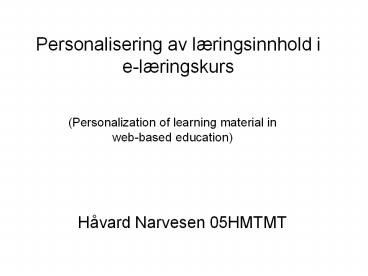(Personalization of learning material in web-based education) PowerPoint PPT Presentation
1 / 14
Title: (Personalization of learning material in web-based education)
1
(Personalization of learning material in
web-based education)
Personalisering av læringsinnhold i e-læringskurs
- Håvard Narvesen 05HMTMT
2
Overview
- Employer Apropos Internett (Hamar, Norway)
- Main task Study ways to adapt learning material
based on individual competence gaps - Supervisor Rune Hjelsvold
- Keywords E-learning, personalization, adaptive
hypermedia
3
Introduction
What is a Learning Management System (LMS)? What
is the problem with presentation of most
web-based education material today? How can
personalization improve web-based education?
4
Problem area
One-size-fits-all-scenario
Personalized material
5
Why personalize learning material?
- It makes web-based courses more relevant to each
learner. - By making e-learning courses adaptable to each
learners pre-knowledge, learners may start the
same course at different entry levels. - If the learning material doesnt feel relevant,
then the learners motivation weakens. Audun
Gjevre, Apropos Internett
6
Research questions
- S1 Hvilke egenskaper bør et nettbasert
læringssystem inneha for å støtte personalisering
av læringsinnhold basert på hver kursdeltakers
kompetansegap? - S2 Hvilke er de største tekniske utfordringene
ved implementasjon av et adaptivt e-læringskurs,
der innhold tilpasses basert på kursdeltakerens
forhåndskunnskaper? - S3 Hvordan oppfatter kursdeltakerne
automatisert pretesting?
7
Method
- S1 A literature study and an interview with an
expert was used to understand relevant concepts
and point out key characteristics of educational
adaptive learning systems.
- S2 A prototype of a system, capable of
personalizing learning material, was build in
order to bring out major technical difficulties.
- S3 An experiment was carried out to get feedback
from a set of learners on implemented
personalization techniques. Qualitative and
quantitative methods were used to gather data.
8
Some results Study of characteristics (S1)
- By pre-testing each users knowledge prior to the
web-based course, it is possible to unveil human
competence gaps, and let them influence the
personalization. - The pre-test cannot be too resource-demanding
neither for teachers or learners. - Computer agents are commonly used to support
learners in modern web-based educational systems.
9
Some results Technical challenges (S2)
- Describing and dividing learning material suited
for personalization. The SCORM standard is not
perfectly suited for advanced personalization.
(Abdullah et al., 2003) - Building automated pre-tests, and then evaluate
the results - Automatically adapt learning material to each
learner based on results from the pre-test and
the learning goals. (Knowledge based) - Implementation of agents for supporting
adaptation ? one learner many teachers
10
The experiment
- A test group of 11 learners used the prototype to
carry out a web-based course. - The course concerned computer viruses.
- A simple pre-test determined the available
learning material.
11
- The structure of the course
- The pre-test was organized as follows
- This means that the pre-test consists of the
users pre-knowledge for each of the main topics
in the course. The pre-knowledge was included as
a part of a user model.
12
Some results Experiment (S3)
- All participants agreed to spend 5 or more of
the total time a course demands in order to
personalize a course (in the future). - Only 2 of the 11 learners fully agreed with the
technique for filtering learning material
implemented in the prototype. These results
confirms conclusions from other researchers that
creating a system that can predict every learners
competence gap with 100 accuracy, is
unrealistic. - Also, the learners view on Personalization in
e-learning, how they like to be tested, how they
liked link-personalization and more.
13
General conclusion (preliminary)
- The experiment in this work, and other studies,
suggest that a pre-test should be used to decide
which learners that need (or not need) extra
attention, rather than entirely delimit the
course material. - Most test-learners did not like that the system
totally decided what they should read and not.
Based on information from the learners, the
pre-test results should rather be used to make a
suggestion of what to prioritize in the
e-learning course.
14
- Thank you for your attention!
- Any comments or questions?

